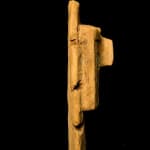Chimu Wood Figure, 900 CE - 1200 CE
Wood
5 x 9 x 3
DE.051 (LSO)
This monolithic wooden figure was carved during the Chimu Empire, which was the first genuine Andean superpower. The figure is a geometrically reductivist representation of a human figure, carved from...
This monolithic wooden figure was carved during the Chimu Empire, which was the first genuine Andean superpower. The figure is a geometrically reductivist representation of a human figure, carved from a single piece of wood in a deliberately trompe d’oeil manner, with an elevated central section to represent the face, a more recessed section for the body, and the most protuberant section as the nose. The whole construction is linear and geometric, comprising successive interlocking planes that work harmoniously as a composition. The circumference of the piece is pierced with holes to accept thongs, feathers or other organic materials for the purposes of decoration. The piece may have been more appointed than is currently the case, but the only pigment remaining is that which defines the eyes.
The Chimu spread out of the Andes and covered most of the coastal plain and south of the country. Their main conquest was that of the Moche (or Mochica) people of Northern Peru, a warrior-like and complex society that possessed power and influence out of all proportion to the empire’s small size. Following their victory over the Moche, the Chimu built their capital city – Chan Chan – directly adjacent to their vanquished opponents’ capital, and rapidly became the most powerful and influential Peruvian group to have existed until that point. The Chimu flourished for about 500 years, but fell abruptly with the rise of the Inca empire in the early 15th century AD.
Their artwork is characterised by black ceramics that copy Moche designs, amended to match Chimu historiography and mythology, as well as feather-work and metal casting. The unusually dry conditions of the Northern Coast has resulted in almost unprecedented preservation of organic materials, notably including the wood sculptures that are often absent in other areas. These figures have played a considerable role in the development of 20th century art styles, especially by expressionist or "primitivist" sculptors such as Brancusi. The significance of the figure represented here is debateable, but the corridors of Chan Chan and other sites still preserve harshly geometric wooden sculptures that are believed to represent members of the Chimu pantheon of gods and spirits. The austere and martial nature of Chimu society is in many respects reflected in their art and traditions, which included human sacrifice. The size of the current piece implies that it may have been a shrine figure which received the prayers and probably libations of a small social group.
This is a fascinating piece of South American art.
The Chimu spread out of the Andes and covered most of the coastal plain and south of the country. Their main conquest was that of the Moche (or Mochica) people of Northern Peru, a warrior-like and complex society that possessed power and influence out of all proportion to the empire’s small size. Following their victory over the Moche, the Chimu built their capital city – Chan Chan – directly adjacent to their vanquished opponents’ capital, and rapidly became the most powerful and influential Peruvian group to have existed until that point. The Chimu flourished for about 500 years, but fell abruptly with the rise of the Inca empire in the early 15th century AD.
Their artwork is characterised by black ceramics that copy Moche designs, amended to match Chimu historiography and mythology, as well as feather-work and metal casting. The unusually dry conditions of the Northern Coast has resulted in almost unprecedented preservation of organic materials, notably including the wood sculptures that are often absent in other areas. These figures have played a considerable role in the development of 20th century art styles, especially by expressionist or "primitivist" sculptors such as Brancusi. The significance of the figure represented here is debateable, but the corridors of Chan Chan and other sites still preserve harshly geometric wooden sculptures that are believed to represent members of the Chimu pantheon of gods and spirits. The austere and martial nature of Chimu society is in many respects reflected in their art and traditions, which included human sacrifice. The size of the current piece implies that it may have been a shrine figure which received the prayers and probably libations of a small social group.
This is a fascinating piece of South American art.



